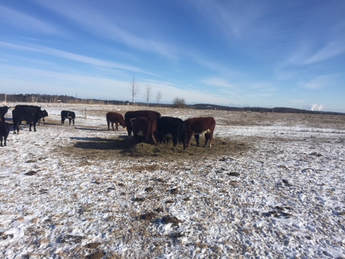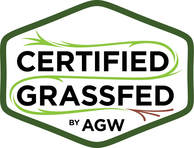 Sustainability These days I hear “Nose to Tail cooking” as a culinary trend and I’m happy about that! Nose-to-tail cooking is all about sustainability, and this is very important to us- and it should be for you too! See, a farmer can’t raise a pork chop. A farmer can’t raise a rib eye steak, or a leg of lamb. You have to raise a whole pig, a whole lamb, and a whole cow. It’s pretty simple: Tossing out valuable parts of the animal doesn’t make sense environmentally or economically. But what does “nose to tail” mean? It means eating and using all parts of the animal- its less popular steaks, roasts, organ meats, bones, even the tallow has (once again) become a popular fat to use for cooking. This is why by selling in bulk, we encourage sustainability, and a more economical way for our customers to get quality grass fed beef. Nose to Tail Around the World Using the whole animal is a practice that is still common in many countries around the world. We experience this firsthand in travels to Uruguay and Argentina- where they are so proud of their (grass fed) beef and will gladly talk to you for hours about where it comes from, the different cuts, how to cook it, and how to eat it. In Barcelona, we went to the famous market “La Boqueria” where they sell everything under the sun, including EVERY cut imaginable of meat. I admit seeing the lamb’s head for sale blew me away! However, aside from this ultra-foodie “nose- to tail eating” trend, it has largely slipped from the Western mindset. I think this is mainly due to the lack of connection we have from our food sources, embodied by the fact that meat has become industrialized and is now perfectly portioned into pink patties, shrink-wrapped in plastic and resembling in no way whatsoever any known animal. Unfortunately for us, in our finicky attitudes about food, we’ve been overlooking fine cuts of meat, tasty delicacies and, of course, the spice of life — variety! Honoring the Animal and Our Environment To maximize the nourishment you can receive from a living creature is to honor that it was, in fact, living. By not using the whole animal, we’re not respecting other living creatures. Giving thanks to the animal for supplying your meal is a good start, but it’s really when we choose to honor the whole animal that we take a step forward in mindful consumerism and changing our food supply system. In so doing, we encourage a mindset that fights excess waste and increases appreciation for the animals that nourish us. For Your Health A direct effect of eating the whole animal is- it’s good for your body. As I learned in my nutrition studies, Americans tend to promote certain cuts more than others (i.e. chicken breast, salmon, tenderloins, etc..) but the reality is, just like humans, animals store different nutrients in different parts of their bodies, and by eating the same cuts over and over, you are getting the same nutrients and neglecting to get other important ones. Our Own Experience A few years before starting our farm, we bought our first ¼ beef steer from our farming mentor, and now friend, Krusen Grass Farm in Wisconsin for our own beef consumption. I won’t lie, when Paul told me about trying it out, I hesitated. At that point, I knew nothing about “bulk buying”, how it works, how much beef I was going to get, and exactly what cuts. I was used to cooking with ground beef and the occasional steak Paul would throw on the grill, but beyond that, I knew nothing about a pot roast, a round steak, and slow cooking beef was a concept beyond my culinary repertoire. The experience of buying in bulk opened a new world of cooking and flavors for us! We had to do something with the cuts of beef I knew nothing about- so I’d look for a recipe, cook it up (way easier than I ever thought) and be surprised by how delicious and easy it was to cook all these different cuts!. We were very pleased by chuck steaks, and top butt steaks, rump roast, sirloin tip, round steaks, and even tried a couple of liver pate recipes that actually delighted us! This idea that by buying a ¼ of an animal, splitting the entire animal with others, gave us a good feeling that we were honoring the whole animal as well as helping the farmer go through its inventory. We encourage our customers to buy in bulk, but otherwise to try different cuts of beef. We are here to help with cooking instructions and/or recipe ideas! And stay tuned for next month when I will blog about “Nose to Tail How-To”.
0 Comments
 While it has felt rather “springlike” lately , we sure had a rough cold stretch here in the Midwest, starting our (official) winter season with sub zero temperatures. Many were asking me… What is winter like at the farm? Well, cold. But as far as our work and the cattle, this is what happens. Preparation In preparation for the winter, we cut and bale all our excess grasses in the summer in the form of hay for winter-feed. Also before winter hits, we give “pedicures” to all our older girls and donkeys, as we want them to have sure footing moving around in winter. We also pull out the bulls to tighten our calving season and have the cows give birth in spring/early summer on our green pastures, just as nature does it. Feeding During these months, while the cattle are still outside, once a week we set out bales of hay for a whole week out in the fields in different rows. Every day we open a fence with 4 to 5 big bales of hay in one row, cut them open and the cows move in to eat. We have “rows” like this and we move them with the electric fence. The cattle fertilizes the field with their droppings plus the wasted hay that falls out of their mouths feeds our soil life. They have access to water, salt, vitamins, minerals, sea kelp and if they so choose, shelter in the barnyard. Temperature The cattle prefer lower winter temperatures better than the real hot summer, but wind and cold rain are not a good combination, so while they are in pasture all year round, they do have access to the barns during the winter for shelter. Surprisingly to many, we rarely see them in! Our animals’ health is a concern during the winter, but our herd has been doing well as they get all the nutrition and energy they need during these cold months. The breeds of cattle we have (the English breeds) do well in our cold Midwest environment. The cattle grow a thick coat of hair that gets shed during the summer months. The calves have put on a fair amount of fat from the good milk their mothers produce, and the cows are doing well from the high quality hay they get over the winter. This layer of fat is great insulation, and is testament to our rich pastures. The Land All our grasses and plants go into hibernation. Each year we pick a different field to feed the cattle on over the winter. The field that the cattle stay on looks pretty beat up at the end of winter, but it comes back strong in the spring with all the fertility the cattle deposit during the winter months. It also gives our pastures more plant diversity as dormant seed get a chance to germinate with the open space made by the cattle’s foot activity. Other Every season there are repairs. Luckily, we only have had a few mishaps, one of the 2 water systems tripped a GFI breaker and we didn’t notice it soon enough and the system froze into a very large ice cube. The other 300-gallon tank that has a heater has performed well in this weather. Everything has been working quite smoothly this year, but we sure are looking forward to greener grasses and sunnier days! |
AuthorMarisa usually writes about nutrition, grass fed beef, organic agriculture, as well as sharing delicious recipes; Paul writes about farm work- sharing his stories and experiences, and most times... we both collaborate on the stories! Archives
March 2024
Categories
All
|
 RSS Feed
RSS Feed


